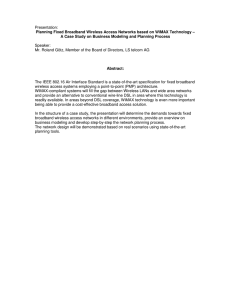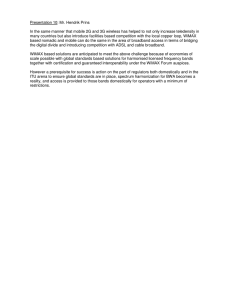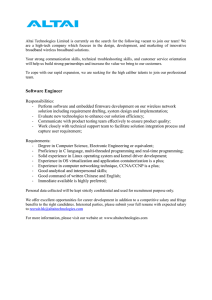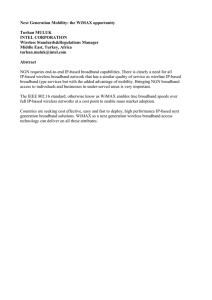Broadband Wireless Options: An Assessment Qualcomm Inc. Luigi Gasparollo
advertisement
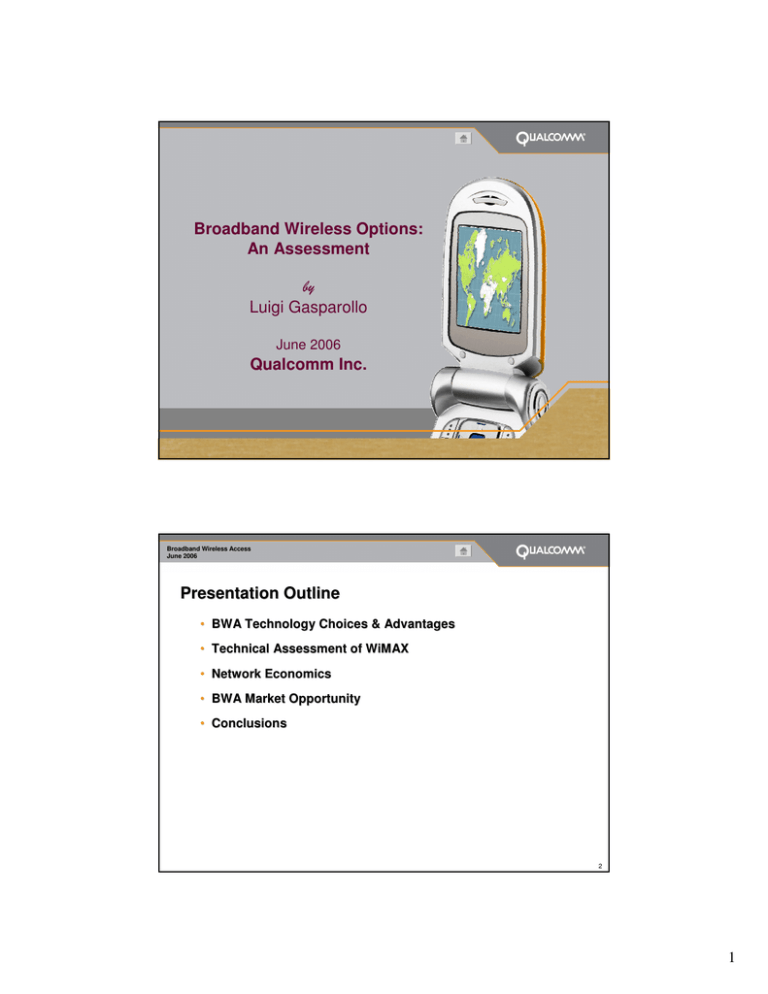
Broadband Wireless Options: An Assessment Luigi Gasparollo June 2006 Qualcomm Inc. Broadband Wireless Access June 2006 Presentation Outline • BWA Technology Choices & Advantages • Technical Assessment of WiMAX • Network Economics • BWA Market Opportunity • Conclusions PAGE 2 2 1 Broadband Wireless Access June 2006 Advantages of 3G, WiWi-Fi and WiMAX The right wireless technology for the right application WiWi-Fi • Wi-Fi offers a high-speed, low cost, wireless LAN connection for homes, campuses and enterprises 3G Technologies • 3G offers ubiquitous access to toll-quality voice & broadband data services within a wide area • 802.11n will enable 100+ Mbps throughputs • Market success is not predicated on service model • Voice capacity and broadband data capabilities continue to grow • 3G economies of scale are enormous, leading to greater product availability and lower costs • Advanced 3G technologies such as EV-DO Rev. A/B and HSDPA/HSUPA highly leverage existing 2G/3G network buildouts and coverage WiMAX • WiMAX offers a cost effective backhaul alternative for 3G base stations and Wi-Fi hotspots • WiMAX may supplement existing broadband services • Fixed broadband access in areas where it is not cost effective to deploy DSL, cable, fiber, landline, etc. • Market opportunity may be limited PAGE 3 3 Broadband Wireless Access June 2006 WiMAX Assessment 3G CDMA PAGE 4 4 2 Broadband Wireless Access June 2006 WiMAX Technology & Targeted Market Segments • The WiMAX Forum promotes IEEE 802.16 standards to target two distinct market opportunities: 802.16-2004: Fixed Broadband Wireless Access (FBWA) • • • • • Wireless backhaul, LOS & NLOS Competitive broadband offering to DSL, cable, etc. OFDM technology (256 OFDM) Uses a variety of bandwidths (3.5 MHz, 5.0/5.5 MHz, 7.0 MHz, and 10 MHz) Targeted bands • • Licensed: 2.5 GHz and 3.5 GHz Unlicensed: 5.8 GHz 802.16e: Portable & Mobile BWA • • • • Portable notebooks and mobile handsets, NLOS OFDMA technology (128, 512,1024 & 2048 FFT) Uses a variety of bandwidths, initially 5 MHz, and claims 15 Mbps peak rates Targeting bands extending to 6 GHz PAGE 5 5 Broadband Wireless Access June 2006 Downlink Throughput Comparison: DO and HSDPA Outperforms WiMAX in Mobile Environment 12000 Average Physical Layer Throughput per Sector in 10MHz 10000 kbps 8000 6000 4000 2000 Rx Diversity Rx Diversity Single Antenna Single Antenna Rx Diversity Single Antenna 0 WiMAX 2 kbps/sector HSDPA 3 4,500 7280 - 10,400 5MHz 5,600 - 7,600 DOrA 4 7350 - 10,500 Simulation assumptions: 1 Full buffer; ITU channel models: pedA 3km/h 30%, pedB 10km/h 30%, vehA 30km/ 20%, pedA 120km/h 10%, Rician 10% for all technologies 2 No Guard band assumed for WiMAX, frequency reuse of 1 is considered 3 Perfect Linear MMSE equalizer assumed, back off 0.75dB 4 Equalizer gain simulated; 1.25MHz carriers, 7 in 10MHz PAGE 6 6 3 Broadband Wireless Access June 2006 Mobile WiMAX Performance • Extensive simulations based on proven ITU mixed channel model and 3G methodologies show: • 3G Broadband offers greater spectral efficiency higher data throughput • Mobile WiMAX spectral efficiency is in the order 0.5 to 0.8 bits/sec/Hz • DOrA & HSDPA spectral efficiency performance is 15%-35% better than Mobile WiMAX in a FDD deployment scenario • Studies indicate that the spectral efficiency of Mobile WiMAX in TDD scenarios will be no different • Physical Layer Design and basic technical framework between FDD and TDD scenarios are retained • Physical Layer Frame Structure is very similar • Control Channel design is very identical between FDD and TDD modes • Resource allocation, overhead management and interference reduction mechanisms are all similar between the two duplexing modes • IEEE802.20 technology is a far superior technology option for TDD unpaired spectrum with channel BWs scalable from 5 MHz up to 20 MHz PAGE 7 7 Broadband Wireless Access June 2006 IEEE 802.20 Mobile Broadband Technology • MIMO optimized • FDD and TDD modes • Radio channels up to 20 MHz wide in licensed spectrum • User peak rates of over 260 Mbps (DL) and 60 Mbps (UL) • Superior performance for all deployment scenarios • Macro-cellular, micro-cellular and hotspots • System designed from ground up for mobile broadband • Flexible airlink resource management with efficient, low-overhead signaling • Advanced interference management • Distributed power control • Fractional frequency re-use for cell edge performance and • Frequency hopping modes • Proven/mature mobility mechanisms provide seamless, low latency handoffs • Fast sector selection using uplink CDMA control channels PAGE 8 8 4 Broadband Wireless Access June 2006 IEEE 802.20 Expected Throughput Performance FDD, BW per link TDD 2:1, total BW 10 MHz 20 MHz 10 MHz 20 MHz Peak Forward Data Rate (1) 140 290 91 190 Peak Reverse Data Rate 34 70 9 20 Forward Average Sector Throughput (2) 21 44 15 32 Reverse Average Sector Throughput (3) 12.5 26 3.4 7.1 Forward Spectral Efficiency (estimate) (2) ~2.2 bps/Hz ~2.3 bps/Hz Reverse Spectral Efficiency (estimate)(3) ~1.3 bps/Hz ~1.0 bps/Hz All data rates in Mbps, except where indicated 1 FL peak data rates based on 4x4 MIMO 2 FL throughput and Spec Efficiency is estimated based on 4x4 MIMO at vehicular speed 120 km/h, TDD DL/UL partitioning assumed to be 2:1. 3 RL throughput and Spec Efficiency is based on 4 Rx BS antennas at vehicular speed 120 km/h. TDD DL/UL partitioning assumed to be 2:1. PAGE 9 9 Broadband Wireless Access June 2006 Mobile WiMAX Link Budget • Studies show WiMAX has a lower link budget than 3G technologies • DOrA & HSDPA offer ~5dB link budget advantage over Mobile WiMAX • Mobile WiMAX will require ~2x the number of cells to provide same coverage in same frequencies • Cell counts will be much higher, given the higher frequencies targeted by WiMAX PAGE 10 10 5 Broadband Wireless Access June 2006 General Observations • Inefficient message based power control (as opposed to bit based) • Affects attainable link margins and data rates on the Uplink; Leads to lower Uplink average spectral efficiency • Inefficient message based sleep mode operation • Leads to higher battery consumption • Inefficient handoff design • Seamless soft handoffs will be difficult to implement • Network procedures are not properly defined • Limited number of simultaneous users can be supported • High overhead Mobile WiMAX is not optimally designed for mobility PAGE 11 11 Broadband Wireless Access June 2006 Network Economics PAGE 12 3G CDMA 12 6 Broadband Wireless Access June 2006 Cell Radius Comparison • 3G technologies provide better coverage than WiMAX in the same frequency bands 3.50 3.00 Urban Radius [km] Suburban Radius [km] Cell Radii (km) 2.50 2.00 1.50 1.00 0.50 0.00 DOrA 800 802.16e* 800 UMTS 1900 DOrA 1900 802.16 2500 802.16 3500 Urban Radius [km] 1.12 0.81 0.77 0.69 0.38 0.28 Suburban Radius [km] 2.9 2.1 2.2 2.0 1.2 0.9 Assumptions: Link budget: DorA and 802.16 RL minimum data rate at 9.6kbps, UMTS minimum data rate at 12.2kbps Propagation model: Hata model in 800MHz, Cost-Hata model in 1900MHz, 2500MHz and 3500MHz * Comparison for 802.16e and CDMA2000 800 MHz frequency is not a typical implementation PAGE 13 13 Broadband Wireless Access June 2006 Normalized Site Counts Comparison • 3G technologies need less sites than WiMAX to cover the same area 900% 800% Urban [%] Suburban [%] 700% 600% 500% 400% 300% 200% 100% 0% UMTS 1900 DOrA 1900 802.16 2500 802.16 3500 Urban [%] 100% 123% 401% 766% Suburban [%] 100% 123% 357% 583% Assumptions: Link budget: DorA and 802.16 RL minimum data rate at 9.6kbps, UMTS minimum data rate at 12.2kbps Propagation model: Cost-Hata model used for all the frequencies PAGE 14 14 7 Broadband Wireless Access June 2006 Network Economics: WiMAX, HSDPA & DOrA • Spectral Efficiency: 3G Advantage Spectral Efficiency WiMAX 2 Rx HSDPA 2 Rx DOrA 2 Rx In 10 MHz .76 1.04 1.05 (bps/Hz/sector) Spectral Efficiency Assumptions: • Sector throughput in 10MHz divided by 10MHz, unit: bps/Hz/Sector • Simulation assumptions: - Full Buffer - ITU Channel Models/probabilities: pedA 3km/h 30%,pedB 10km/h 30%,vehA 30km/h 20%,pedA 120km/h 10%,Rician 10% • WiMAX sector throughput: 2rx, 7600kbps in 10MHz. No guard band assumed, Frequency reuse 1 • DOrA sector throughput: 2rx with equalizer, 10,500kbps for 7 of 1.25MHz carriers in 10MHz • Spectral efficiency drives network expenses Network Expenses WiMAX 2 Rx HSDPA 2 Rx DOrA 2 Rx In 10 MHz $12.00 $10.40 $10.37 (NetX/Gbyte) NetX Assumptions: • Network Expense includes all network operations expenses and depreciation on network capital • 7.5% Busy Hour, Assumes 3 sector sites, Capacity Constrained Network • Equipment Cost $135k/3 Sector site • Includes BHaul ($4000/mbps/year) and Interconnect ($3000/mbps/year) Expense PAGE 15 15 Broadband Wireless Access June 2006 BWA Market Opportunity 3G CDMA PAGE 16 16 8 Broadband Wireless Access June 2006 Cost & Scale Subscriber Forecasts by Technology 3G Broadband subscribers will approach 800 million within the Next 5 Years Total Subscribers Worldwide (2005 - 2009) 800 (Subscribers in Millions) 700 WCDMA CDMA2000 1xEV 600 Fixed & Mobile WiMAX 536 500 400 366.9 300 228.9 200 100 118.9 50.4 67.9 0 2005 2006 251.9 187.8 122.2 24.6 17.2 2007 2008 2009 Sources: 1. WCDMA & CDMA2000 1xEV: Blended forecast from Strategy Analytics (Dec. 2004) and Yankee Group (March 2005); 1xEV includes 1xEV-DO & DV subs 2. WiMAX: Blended forecast from Strategy Analytics (Mar. 2005) and Gartner (Dec. 2004) PAGE 17 17 Broadband Wireless Access June 2006 Global Wireless Device Shipments by Technology 3G (CDMA2000 and WCDMA) will Make Up 60% of Total Shipments by 2009 (Millions) 1,000 CDMA2000 / WCDMA 900 1G / 2G / 2.5G * 800 600 537 432 454 428 415 457 2001 2002 2003 400 833 854 358 441 866 141 201 268 555 536 522 80 39 300 200 804 697 700 500 756 557 475 413 345 100 0 2004 2005 2006 2007 2008 * Includes cdmaOne, GSM/GPRS/EDGE, TDMA, PDC, and Analog Source: Average of Strategy Analytics (August and Yankee Group (June 2005) handset forecasts PAGE2005) 18 2009 18 9 Broadband Wireless Access June 2006 WiMAX* CPE / Subscriber Unit Forecasts 30 28M 25 20M 20 15 12M 10 7.5M 5M 5 3M 1M 0 2005 2006 2007 2008 2009 Shaded area represents ranges between lowest and highest forecasts for shipments of fixed and portable/mobile WiMAX CPEs/subscriber equipment. Forecasts include ABI Research (Q3, 2005), Forward Concepts (September 2005) and Strategy Analytics (March 2005). *Includes both 802.16-2004 and 802.16e PAGE 19 (fixed and portable/mobile) shipments 19 Broadband Wireless Access June 2006 Industry Analysts Forecast 3G CDMA Devices Grow to 60% of Worldwide Sales by 2009 (Millions) CDMA and WCDMA Worldwide Handset Shipments 600 60% 500 400 300 505 25% 200 423 340 256 100 194 139 0 39 2002 78 2003 2004 2005 2006 2007 2008 2009 Source: Average of Strategy Analytics (August 2005) and Yankee Group (October 2005) handset forecasts PAGE 20 20 10 Broadband Wireless Access June 2006 Wireless Market Opportunity 3G Broadband will create more industry value, with a focus on service revenue Worldwide Service and Equipment Revenue, 2009 2009 Market Size: • 3G Evolution (incl. 3G mobile broadband) $508 $500 • $394 B in service revenues1 • $114 B in equipment revenues2 • 960M subscribers by 20093 Service Revenue Equipment Revenue • Wi-Fi Evolution (802.11 a,b,g,n) • $3.5 B in public Wi-Fi service revenues1 • $9.9 B in equipment revenues4 • 48M subscribers by 20091 • WiMAX (802.16-2004, 802.16e-2005) • $7.4 B in service revenues1 • $3 B in equipment revenues5 • 25 M subscribers by 20096 $US, Billions $400 $300 $394 $200 $100 1 Source: Strategy Analytics (2006) 2 Source: Average of Strategy Analytics and Yankee Group forecasts (2006) 3 Source: Average of iGR, Informa WCIS, Strategy Analytics and Yankee Group forecasts (2006) 4 Source: Forward Concepts (2005) 5 Source: Average of Strategy Analytics (2006), Gartner (2006) and Forward Concepts (2005) 6 Source: Average of Strategy Analytics (2006) and Gartner (2005) PAGE 21 $114 $13.4 $10.4 Wi-Fi WiMAX $0 3G 21 Broadband Wireless Access June 2006 Summary Time to Market Technical Performance • 3G data rates and capacities are comparable to or better than Mobile WiMAX* • 3G leverages existing 2G/2.5G coverage; 3G coverage is better than Wi-Fi & Mobile WiMAX • 802.20 complements EV-DO evolution with a compelling TDD solution for large spectrum allocations • 3G broadband has at least a 4-year time-to-market advantage over Mobile WiMAX • Since 2002, hundreds of 3G handsets, PDAs and PC card have been commercialized • 3G technologies will be embedded into laptop PCs from leading manufacturers starting in 2005 * Given equivalent channel bandwidths, coverage and allocated spectrum Cost & Scale Business Case • 3G devices can be purchased for $50 in certain markets today* • 3G forecasts indicate strong service revenues and equipment & device shipments** • 3G expects to reach more than 800M subs, while WiMAX may reach 33M subs (2009) • Multi-mode devices with 3G & MBWA 802.20 combine are poised to gain a major share of the Metro Area Deployments • 802.11a/b/g is available today at low price points • 802.11n will offer better performance within the home and enterprise than WiMAX • Unlike Wi-Fi, the WiMAX market opportunity will require an operator business case; • 3G technologies will continue to lower the cost per bit for core operator services * Commercial LG units shipping to Reliance in India ** Source: ABI, Gartner, IDC, In-Stat/MDR, Strategy Analytics, 2004 & 2005 PAGE 22 22 11 12
